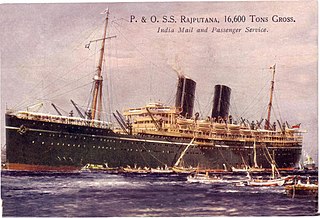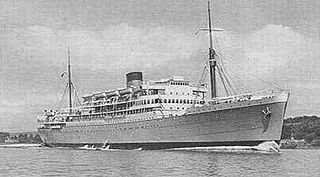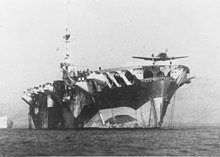
An armed merchantman is a merchant ship equipped with guns, usually for defensive purposes, either by design or after the fact. In the days of sail, piracy and privateers, many merchantmen would be routinely armed, especially those engaging in long distance and high value trade.

USS Jamaica (CVE-43), was an escort carrier of World War II that served in the British Royal Navy as HMS Shah (D21). Returned to the United States at war's end, she was converted into a merchant vessel and she was sold into civilian service in 1946 as Salta. She was ultimately scrapped in 1966.

HMS Biter was a Royal Navy escort carrier during the Second World War. She was laid down as a merchant ship at the Sun Shipbuilding & Drydock Company yard at Chester, Pennsylvania. Laid down on 28 December 1939, she was converted to an escort carrier and commissioned in the Royal Navy on 6 May 1942. She was returned to the United States in 1945 and subsequently lent to France.
HMS Audacity was a British escort carrier of the Second World War and the first of her kind to serve in the Royal Navy. She was originally the German merchant ship Hannover, which the British captured in the West Indies in March 1940 and renamed Sinbad, then Empire Audacity. She was converted and commissioned as HMS Empire Audacity, then as HMS Audacity. She was torpedoed and sunk by a German U-boat in late 1941.

HMAS Kanimbla was a passenger ship converted for use as an armed merchant cruiser and landing ship infantry during World War II. Built during the mid-1930s as the passenger liner MV Kanimbla for McIlwraith, McEacharn & Co, the ship operated in Australian waters until 1939, when she was requisitioned for military service, converted into an armed merchant cruiser, and commissioned in the Royal Navy as HMS Kanimbla.

HMS Vindictive was a warship built during the First World War for the Royal Navy (RN). Originally designed as a Hawkins-class heavy cruiser and laid down under the name Cavendish, she was converted into an aircraft carrier while still being built. Renamed in 1918, she was completed a few weeks before the end of the war and saw no active service with the Grand Fleet. The following year she participated in the British campaign in the Baltic against the Bolsheviks, during which her aircraft made numerous attacks against the naval base at Kronstadt. Vindictive returned home at the end of the year and was placed in reserve for several years before her flight decks were removed and she was reconverted back into a cruiser. The ship retained her aircraft hangar and conducted trials with an aircraft catapult before she was sent to the China Station in 1926. A year after her return in 1928, she was again placed in reserve.

HMS Rawalpindi was a British armed merchant cruiser that was sunk in a surface action against the German battleships Scharnhorst and Gneisenau during the first months of the Second World War. Her captain was Edward Kennedy.

HMS Avenger was a Royal Navy escort aircraft carrier during the Second World War. In 1939 she was laid down as the merchant ship Rio-Hudson at the Sun Shipbuilding & Drydock Company yard in Chester, Pennsylvania. Launched on 27 November 1940, she was converted to an escort carrier and transferred under the lend lease agreement to the Royal Navy. She was commissioned on 2 March 1942.

HMAS Westralia (F95/C61) was an auxiliary cruiser of the Royal Australian Navy (RAN). Built by Scottish shipbuilder Harland and Wolff and completed in 1929, Westralia was operated by the Huddart Parker company until 1939, when she was requisitioned for service with the RAN as an Armed Merchant Cruiser (AMC). Fitted with guns and commissioned in early 1940, Westralia was initially used to escort convoys in the Pacific and Indian oceans. In November 1940, the largest mutiny in RAN history occurred aboard the ship, with 104 men charged.

SS Rajputana was a British passenger and cargo carrying ocean liner. She was built for the Peninsular & Oriental Steam Navigation Company at the Harland and Wolff shipyard at Greenock on the lower River Clyde, Scotland in 1925. She was one of the P&O R-class liners from 1925 that had much of their interiors designed by Lord Inchcape's daughter Elsie Mackay. Named after the Rajputana region of western India, she sailed on a regular route between England and British India.
Pretoria Castle may refer to one of the following ships:

HMS Forfar (F30) was a British ocean liner that was commissioned into the Royal Navy as an armed merchant cruiser in 1939 and sunk by enemy action in 1940. She was launched in Scotland in 1920 as a transatlantic liner for the Canadian Pacific Steamship Company as Montrose. She was one of three sister ships. The others were Montcalm, also launched in 1920, and Montclare, launched in 1921.

HMS Artifex was a repair ship of the Royal Navy from late in the Second World War and into the Cold War. Launched as the Cunard liner RMS Aurania she was requisitioned on the outbreak of war to serve as an armed merchant cruiser. Damaged by a U-boat while sailing with an Atlantic convoy, she was purchased outright and converted to a floating workshop, spending the rest of her life as a support ship for the navy.
The SS Ranpura was a British passenger and cargo carrying ocean liner built by R. & W. Hawthorn Leslie and Company at Newcastle upon Tyne for the Peninsular & Oriental Steam Navigation Company in 1924. She was the first of the P&O 'R' class liners that had much of their interiors designed by Lord Inchcape's daughter Elsie Mackay. She was launched 13 September 1924 and sponsored by C.C. Straker, wife of the chairman of Hawthorn Leslie and Company.

MV Carnarvon Castle was an ocean liner of the Union-Castle Line. She was requisitioned for service as an auxiliary cruiser by the Royal Navy during the Second World War.

708 Naval Air Squadron was a Naval Air Squadron of the Royal Navy's Fleet Air Arm which disbanded during February 1946. It formed during October 1944 at HMS Daedalus, RNAS Lee-on-Solent, as the Firebrand Tactical Trials Unit, before moving to nearby RAF Gosport the following January. Tasked with looking into issues distinct to the Blackburn Firebrand the unit also performed deck landing training and torpedo exercises with the aircraft. The squadron moved to RNAS Ford where a number of personnel including the CO provided the core for the formation of 813 Naval Air Squadron, the Fleet Air Arm’s initial operational Blackburn Firebrand unit. The squadron relocated to RNAS Fearn at the beginning of December and then in January 1946 it moved to RNAS Rattray.
RMS Andes was a 26,689 GRT steam turbine Royal Mail Ship, ocean liner, cruise ship, and the flagship of the Royal Mail Lines fleet. She was the second Royal Mail ship to be named after the South American Andes mountain range. The first RMS Andes was an A-class liner launched in 1913. In 1929 that RMS Andes was converted into a cruise ship and renamed Atlantis.

RMS Asturias was a Royal Mail Lines ocean liner that was built in Belfast in 1925. She served in the Second World War as an armed merchant cruiser until she was crippled by a torpedo in 1943. She was out of action until 1948 when she returned to civilian service as an emigrant ship. She became a troop ship in 1954 and was scrapped in 1957.

HMS Dunvegan Castle was a UK ocean liner that was converted into an armed merchant cruiser (AMC) in the Second World War. Harland and Wolff built her and her sister ship Dunnottar Castle in Belfast in 1936.
















